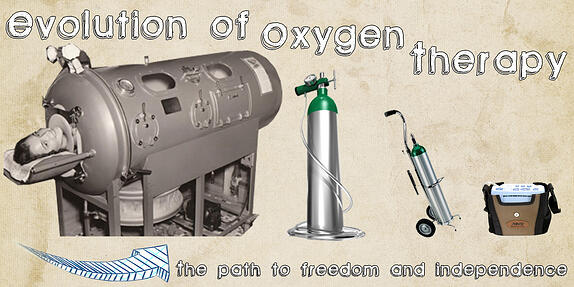
While the techniques used have no resemblance to how oxygen therapy is done today, the importance of it was known back in the 1600s. It came into favor and went out of favor over the years while undergoing a wide variety of implementation. One in the 1900s was a gigantic hyperbaric chamber that included a dining area, smoker's lounge, as well as a bedroom! This was not very portable that is for sure. Hyperbaric chambers still exist, but are used for much different reasons, such as wound healing and diving accidents known as the bends.
In the more recent history of portable oxygen, the heavy metal oxygen tanks were used. These were not really motivational or practical regarding activity. Luckily, all this has changed in recent years. Oxygen therapy has been transformed by the portable oxygen concentrators (POC).
Finally Cleared by FAA in 2005
The oxygen in the original tanks and the liquid-oxygen devices was most flammable and its use was strictly controlled by the airlines. The portable oxygen concentrators of today create their oxygen by removing the nitrogen from the room air. This does not create any hazardous material. Early models weighed about 10 pounds and worked on a battery or electrical current. The two units that were first cleared by the FAA were the AirSep Lifestyle and the Inogen One.
Pulse-Dose And Continuous Flow
There are two main types of portable oxygen concentrators, the pulse-dose and the continuous flow units. The continuous flow system delivers a non-stop flow of oxygen. Because of this continuous flow, these units are larger. The pulse dose unit only delivers oxygen in fixed increments, delivering oxygen when it senses your inhalations. This sensor monitoring of changes in your breathing rate is most efficient, as it delivers more oxygen at times you need it the most. Because it does not deliver a continuous flow, the pulse-dose units conserve the oxygen and it lasts for longer periods.
Your doctor is the one to decide which is best for your health needs. Note that some units are able to deliver both pulse-dose and continuous therapy. The SeQual eQuinox of one of these.
Today's Portable Oxygen Concentrators
Here are a few of the top portable oxygen concentrators available. They all have comfortable cross shoulder travel cases and are quiet enough for dining out, going to the theater or air travel.
AirSep Focus
In contrast to the AirSep Lifestyle mentioned above, one of the newest models from AirSep called the AirSep Focus, weighs only 1.75 pounds. Using two interior batteries and adding the AirSep AirBelt (attaches around your waist) you can extend your use time up to 4 hours.
Inogen One G3
The Inogen One G3 will allow you to travel most any international flight with its 16 cell battery. You get 8-12 hours of therapy with the 16 cell battery. It can be used for both daytime and night time therapy as it is able to adjust to your needs when sleeping.
SeQual eQuinox
The SeQual eQuinox portable oxygen concentrator delivers both the pulse-dose and continuous flow therapy. It is a powerful unit that also includes an Advanced Voice Module Interface. This interface announces each button press or function change which can be most helpful in lowlight situations.
Yes, the portable oxygen concentrators have come quite a way from that multi-room hyperbaric chamber of the 1900s. The options are many. With your doctor's help you will easily find the one that fits your needs in all ways.
+Caleb Umstead



